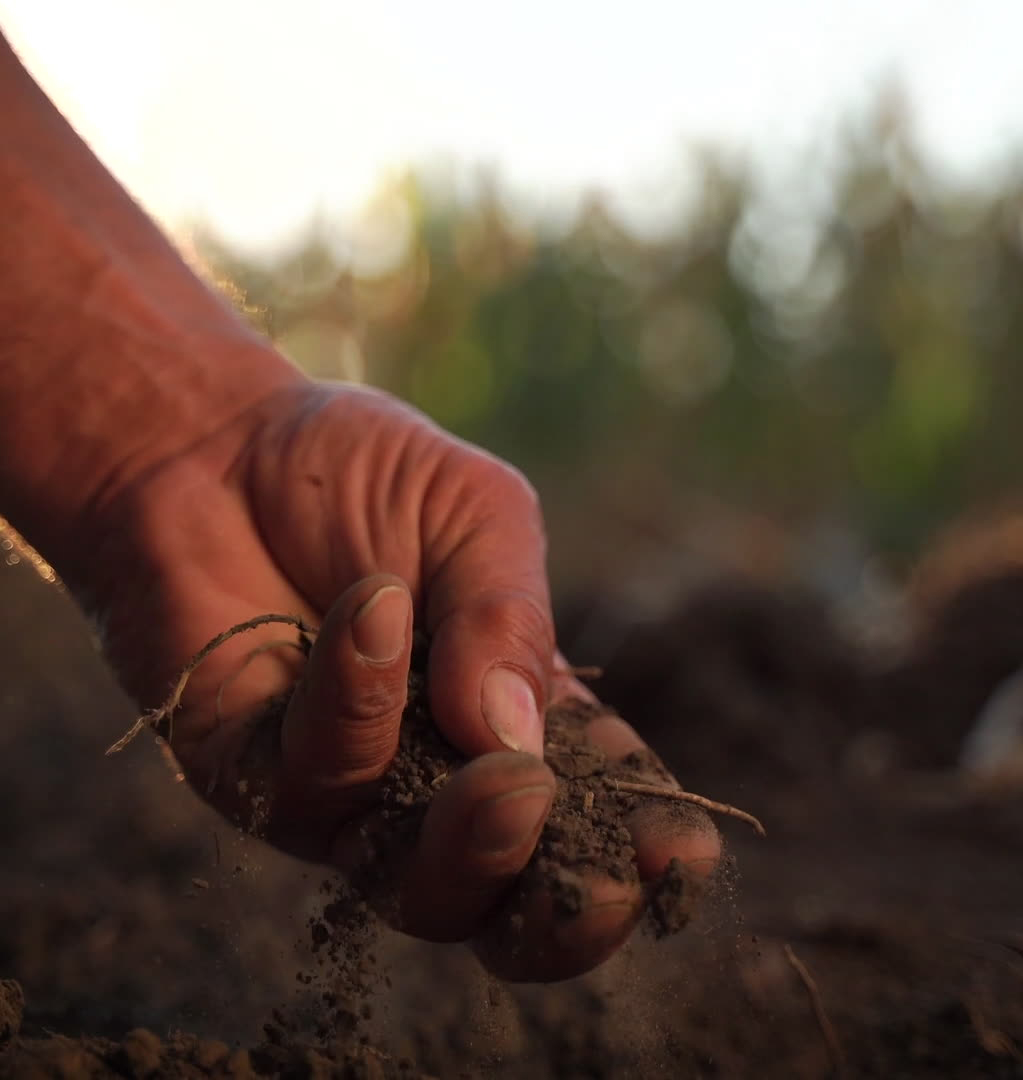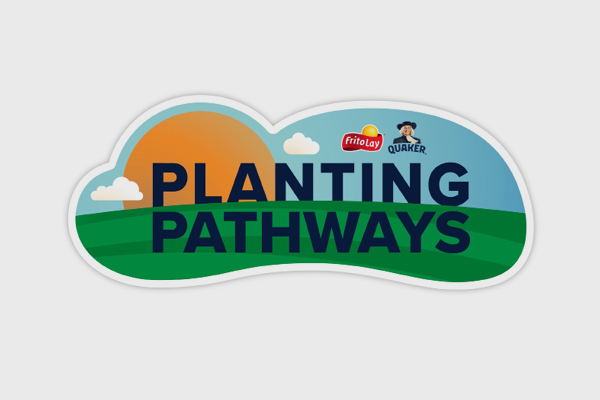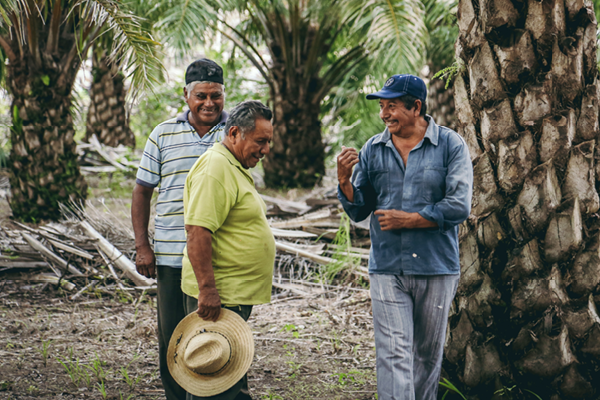ESG Summary
Positive Agriculture
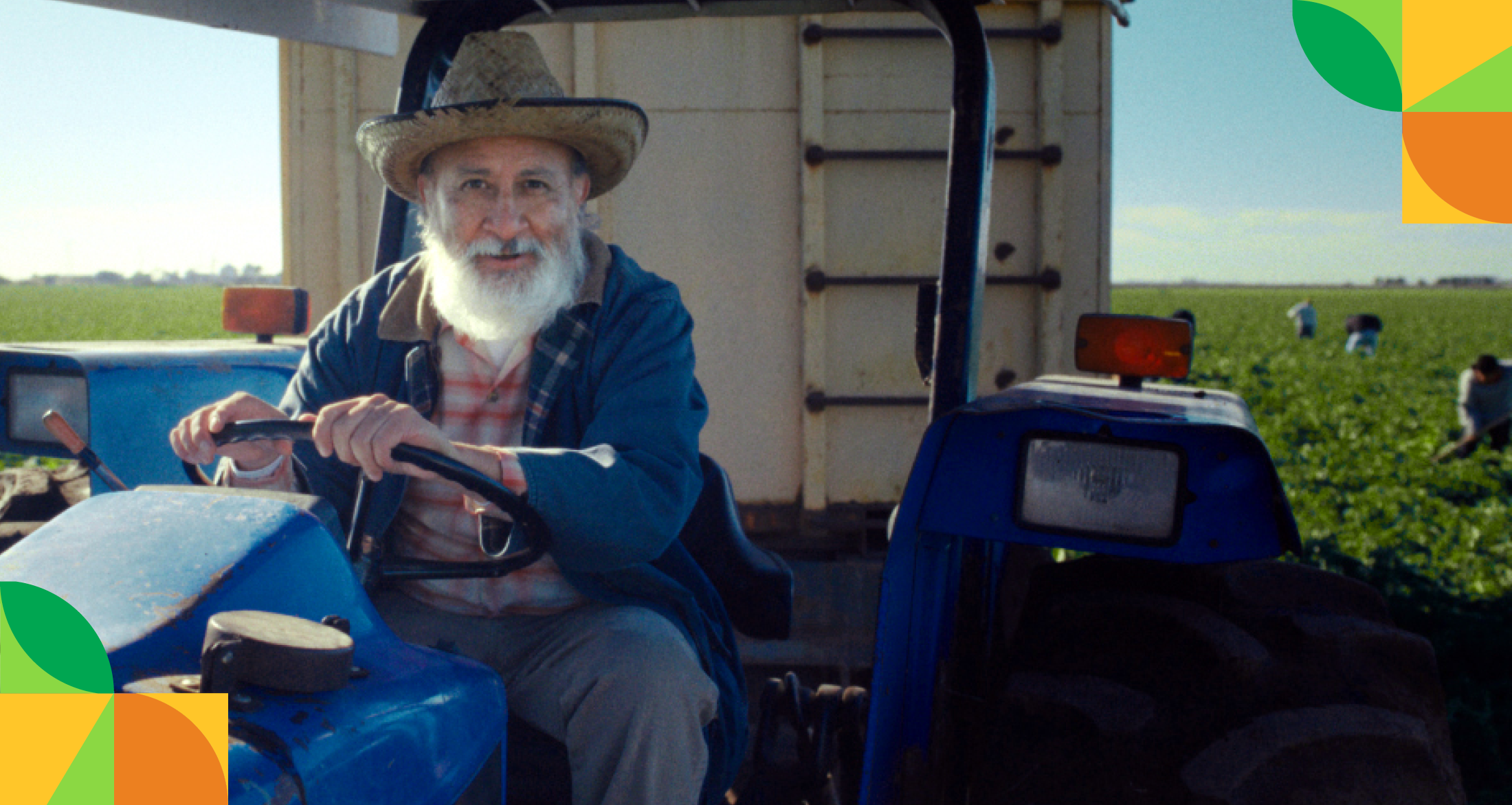
Our business depends on agriculture
We rely on a secure supply of crops and ingredients so we can make our foods and drinks. Put simply, our business depends on agriculture.
Thriving communities and ecosystems support this supply, so we aspire to help farmers grow food in a way that revitalizes the earth and enables resilience.
Our Positive Agriculture agenda is designed to support sustainable food systems by identifying opportunities for action and collaboration and measuring the impact of our efforts. This includes our efforts to help support the advancement of farmers and farming communities, spread the adoption of regenerative agriculture, restorative and protective practices and sustainably source1 our key ingredients in accordance with our guidelines.
Together with many of our customers and suppliers as well as NGOs and governments, we are working to help transform global food systems, while positioning our business for the long-term. By refining our pep+ goals earlier this year — including expanding our regenerative agriculture goal, aiming to spread the adoption of regenerative, restorative or protective practices across 10 million acres by 20302 — we are building on learnings and helping our sustainability ambitions remain actionable and achievable.
Throughout 2024, we made progress across our Positive Agriculture goals. However, we know there is more work to do, and we remain focused on opportunities to expand upon our efforts.
1. Sustainably sourced refers to in-scope ingredient volumes that meet the established criteria outlined in PepsiCo’s Sustainable Sourcing Guidelines. Sustainable Sourcing practices can help manage risks, but challenges like deforestation or social issues can persist in some regions
2. See PepsiCo’s Regenerative Agriculture Guidelines for additional information, including details on key crops and regeneration, restoration and protection criteria. Results reflect total acreage meeting these criteria within the annual reporting period
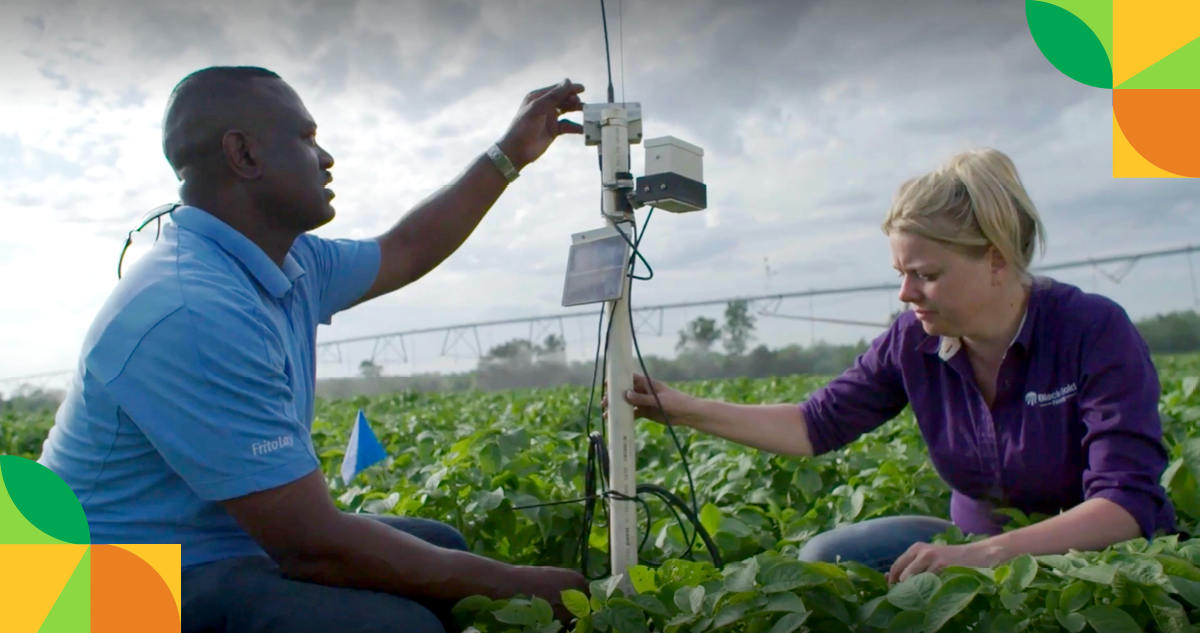
Our agricultural footprint
There are 300,000 farmers in our direct and indirect supply chains around the world who provide approximately 50 agricultural crops and ingredients that make up PepsiCo foods and drinks. These farmers and suppliers help ensure our foods and drinks continue to be enjoyed more than one billion times a day in more than 200 countries and territories around the world.

~50
agricultural crops and ingredients
go into making our products

~60
countries supply agricultural crops
and ingredients for our iconic brands

>3.5MM
acres used regenerative agriculture,
restorative or protective practices in 20241

>185k
Measurable improvements in more than
185,000 livelihoods since 20212
1. Refined goal announced on May 22, 2025. 2024 performance calculated retroactively. For more information, see Calculation Methodology
2. This goal captures the number of livelihoods reached through an outcome-focused evaluation measuring improvements in economic prosperity and farmer and farm worker security. Metric counts the cumulative people impacted since 2021
Approach, goals & progress
The heart of our ambition is to help create a more resilient, sustainable food system
We have made meaningful progress in some areas, while facing challenges in others. Across our Positive Agriculture goals, we strive to scale and accelerate what has worked, continue to work with stakeholders, adopt new technologies and establish partnerships that we believe can have a substantive positive impact.
Notably, we have:
- Increased the adoption of regenerative agriculture, restorative, or protective practices to more than 3.5 million acres1 globally in 2024
- Collaborated with suppliers to work with farmers in different regions to plant cover crops and implement other regenerative practices, resulting in an approximately 1.6 million metric ton net reduction in on-farm GHG emissions, including soil carbon sequestration, in 20242
- Sustainably sourced approximately 66%1 of our key ingredients in line with our Sustainable Sourcing Guidelines in 2024
- Contributed to measurable improvements in more than 185,000 livelihoods based on an outcome-focused evaluation of economic prosperity and farmer and farm worker security since 20213
1. Refined goal announced on May 22, 2025. 2024 performance calculated retroactively. For more information, see Calculation Methodology
2. Carbon sequestration from regenerative agriculture projects is calculated separately and outside of PepsiCo's GHG inventory. Carbon sequestration is not currently factored into PepsiCo's progress against climate goals
3. This goal captures the number of livelihoods reached through an outcome-focused evaluation measuring improvements in economic prosperity and farmer and farm worker security. Metric counts the cumulative people impacted since 2021
Approach to regenerative agriculture
Regenerative agriculture can be a powerful tool to promote healthier soil, as well as to reduce agricultural emissions, enhance biodiversity and watershed health and help raise the standard of living for farmers and farming communities by supporting resilience. We believe it can help mitigate risks for our business while also preserving natural resources for future generations.
Driven by this belief and our progress and learnings to date, earlier this year we increased our regenerative agriculture goal, aiming to drive the adoption of regenerative agriculture, restorative or protective practices across 10 million acres of land by 2030.1 This is an expansion of our original 7-million-acre regenerative agriculture goal and extends the ambition both in scale and depth, as it includes specific objectives for nature within the goal.
Our new goal intentionally brings together efforts to regenerate, restore and protect agricultural lands and surrounding ecosystems to encourage more holistic action. We consider an acre as contributing to nature restoration or protection when activities lead to biodiversity and ecological improvements on lands not used for agricultural production, and which remain out of agricultural production in the future, but which enhance the resilience of the ecosystem in the farming landscape. This could include, for example, increasing critical land area under protection or increasing the governance effectiveness of protected areas. For more information, please see our Regenerative Agriculture Guidelines.
Regenerative agriculture practices are implemented by farmers all over the world — from large-scale commercial farming systems to smallholder farms. In practice, each farm and its surrounding ecosystem is unique. Implementing regenerative agriculture practices requires balancing regenerative practices with current, proven farming tactics adjusted to local ecosystems.
We support farmers in implementing a wide range of outcome-oriented regenerative practices, including planting cover crops to protect the soil, reducing tillage to maintain soil health and encouraging livestock integration and crop diversity. Depending on local conditions, regenerative techniques can help farmers grow more food on the same amount of land with optimized usage of water, fertilizer and pesticides.
We also continue our work in watershed health. During 2023, we exceeded our agricultural water-use efficiency goal of 15%2 (reaching 22% when compared to a 2015 baseline) in high water-risk watersheds two years ahead of schedule by supporting farmers through partnerships, targeted trainings and programs such as our demonstration farms. As a result of achieving this goal ahead of schedule, we will no longer report annual progress against it. However, we will continue our efforts through other pep+ goals, including with targeted interventions embedded within regenerative agriculture programs where water risk necessitates such action. Read more on our approach to water beyond agriculture in Positive Value Chain.
Throughout 2024, we provided support to approximately 20,000 farmers as they adopted regenerative, restorative or protective farming techniques on more than 3.5 million acres3 globally.
Based on our experience collaborating with farmers, we believe there are key components that can support transition to regenerative agriculture practices, including:
- Economic support: Provide farmers with economic support, such as cost-sharing, needed to transition to regenerative agriculture in a secure, more viable way, while also funding innovation and supporting start-up organizations with the potential to scale.
- Community engagement support: Provide farmers with opportunities to connect with peers and community champions of regenerative agriculture through means such as holding field days for farmers to learn from other farmers in their community. For example, we showcase proven practices that work locally through demonstration farms. We currently have 55 demonstration farms around the world.
- Independent agronomic support: Help farmers scale regenerative agriculture, regardless of what stage of the process they are in, by providing technical support to demonstrate how practices will work on their individual farm with its specific soil and weather conditions.
An example of our efforts to provide independent agronomic support includes work with local implementers like Practical Farmers of Iowa (PFI), Soil and Water Outcomes Fund (SWOF) and the IL Corn Growers Association (ICGA). Additionally, we continue to collaborate with like-minded peers across the food system. One example is STEP Up for Agriculture (Supporting Trusted Engagement and Partnership for Agriculture), a pioneering initiative by PepsiCo and Unilever and retailer partners to strengthen the capacity of farmer-facing organizations in the U.S. and Europe. Through tailored advisory support and a "train the trainer" model, the program focuses on building organizational capabilities, promoting regenerative agriculture practices and driving sustainable supply chain solutions with measurable environmental impact.
1. See PepsiCo’s Regenerative Agriculture Guidelines for additional information, including details on key crops and regeneration, restoration and protection criteria. Results reflect total acreage meeting these criteria within the annual reporting period.
2. Measured versus a 2015 baseline. This metric tracked the improvement of the water-use efficiency of PepsiCo’s direct agricultural supply chain. Results reflected assessments performed in 2023, 2020 and 2018
3. Refined goal announced on May 22, 2025. 2024 performance calculated retroactively. For more information, see Calculation Methodology
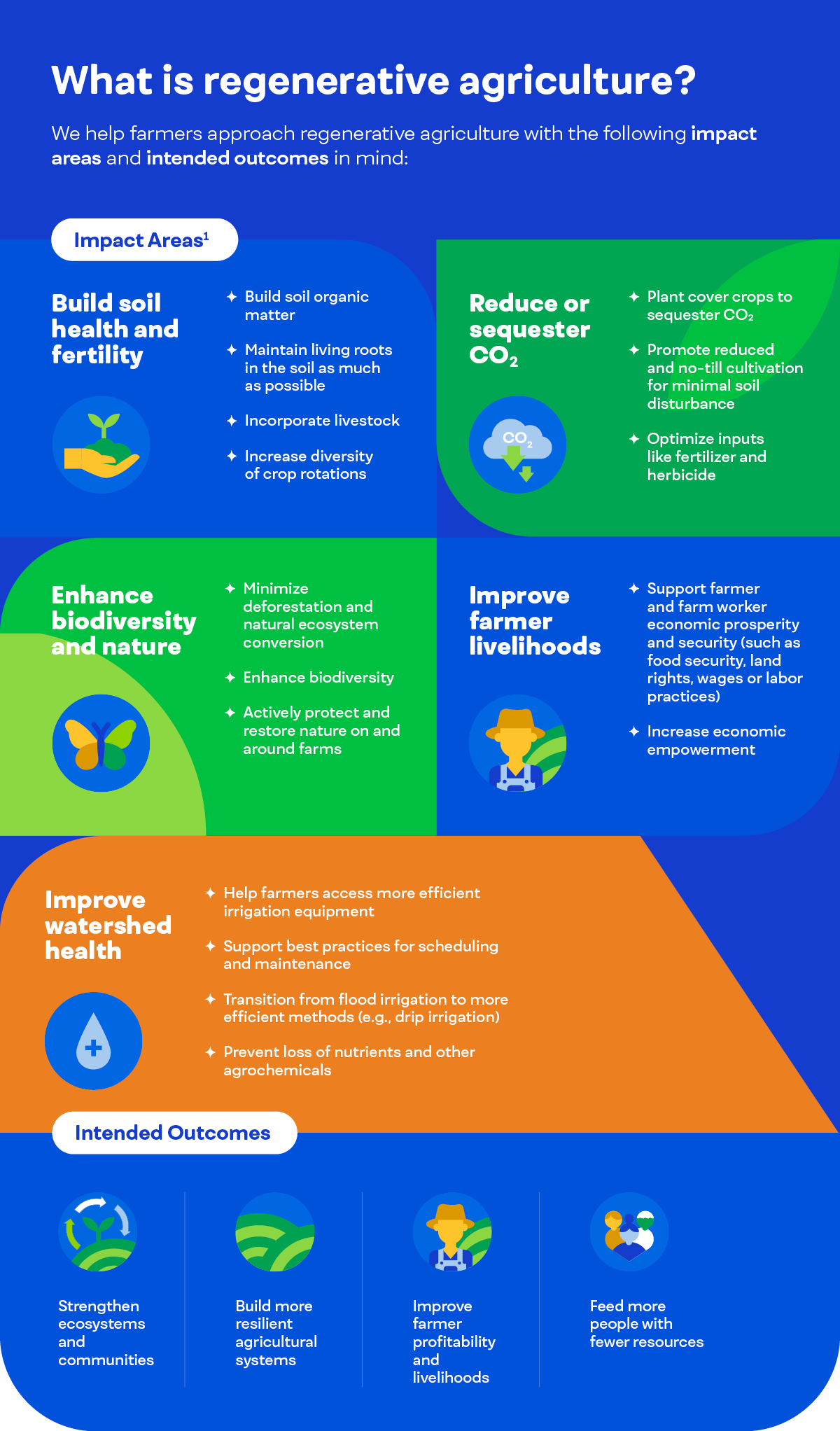
1. Refer to PepsiCo’s Regenerative Agriculture Practice Bank for an indicative listing of practices directly or indirectly linked to the five impact areas
Listening to and collaborating with farmers and stakeholders
We listen to and collaborate with various farmers, farm workers, industry peers and agriculture participants in different parts of our value chain to help transition to more sustainable agriculture practices that deliver farm-level impacts, such as improved soil health and greenhouse gas (GHG) emissions reductions.
Examples of our stakeholder engagements that launched or expanded in 2024 include:- Expanding opportunities in the agriculture sector, including a multi-year partnership with Practical Farmers of Iowa to provide opportunities for underrepresented and beginning farmers and a partnership with the Farm Foundation to create career opportunities within the agriculture industry.
- Awarding $6.7 million in grants to fund innovative regenerative agriculture projects in Canada, Australia and Mexico in partnership with AgMission.
- Partnering with Yara to help decarbonize crop production in Europe by providing farmers with crop nutrition programs to make sure crops get the nutrients needed to grow, including the right amount at the right time, which can help farmers use fewer inputs and help reduce in-field emissions.
- Launching the Sustainability Action Center to help agricultural suppliers set and track emissions reduction targets.
- Continuing to support regenerative agriculture transformation on more than three million acres of U.S. farmland through a partnership with three farmer-facing organizations and a multi-year $216 million investment.
- Scaling efforts to upskill certified crop advisors with soil health training in North America through the Trusted Advisor Partnership.
Fueling innovative grassroots efforts
One way we cultivate innovation in agriculture is by supporting start-ups and grassroots organizations that we believe have the potential to scale. This, coupled with our continued partnerships with large, well-established organizations, helps us unlock business growth and access new ideas and technologies.
Our Positive Agriculture Outcomes Accelerator (the Accelerator) is one example of this in action. The Accelerator aims to incentivize our local teams to design and scale innovative solutions by offering co-investment to projects that have the potential to help progress toward our 2030 pep+ Positive Agriculture goals. By providing both financial and technical support, the Accelerator promotes long-term, transformative ideas that can impact farming communities around the world.Since 2022, we have expanded our work to support eight new innovation projects across eight countries and approximately $5 million has been granted through the Accelerator. These investments support initiatives designed to test new solutions and help farmers build more resilient businesses.
We also continued to provide local farmers with the space to engage in peer-to-peer learning. Our extensive network of demonstration farms around the world offers farmers the opportunity to put into action scalable, innovative practices and solutions.
For example, in 2024 we hosted PepsiCo Milhão Regenera, a demonstration farm field day in Brazil organized together with Milhão Ingredients, a key corn supplier in the region. More than 400 farmers and members of the agriculture community participated, both sharing their experiences with and learning more about regenerative and precision agricultural practices.
Supporting nature-focused objectives
Our Positive Agriculture ambitions include a focus on nature because we believe our business is inextricably linked to the health of the ecosystems that support the growth of crops that ultimately end up in our foods and drinks.
Working to promote nature positive outcomes has been a significant undertaking over the past two decades.1 We recognize the interplay between nature and business is complex, and our understanding continues to evolve. Within our supply chain, we are seeking to identify opportunities to mitigate environmental risks and support nature conservation and restoration.
With this in mind, we have included specific objectives for nature within our expanded regenerative agriculture goal to drive the adoption of regenerative, restorative or protective practices across 10 million acres by 2030.2 We consider an acre as contributing to nature restoration or protection when activities lead to biodiversity and ecological improvements on lands not used for agricultural production, and which remain out of agricultural production in the future, but which enhance the resilience of the ecosystem in the farming landscape.
Examples of recent efforts include:
- Providing farmers, suppliers, NGOs and researchers with actionable insights about how climate change is impacting crops and how they can create resilience through regenerative agriculture with the open-access Climate Resilience Platform (CRP), created with the Alliance of Bioversity International and the International Center for Tropical Agriculture and the Foundation for Food and Agriculture Research. Recognized by Fast Company in 2024 as a “Next big thing in tech” for its contributions to food and agriculture, the CRP tool aims to help boost yields and reduce environmental impact.
- Working to support the transformation of our sourcing regions, including continuing to strive toward deforestation- and conversion-free sourcing for high-risk commodities in our company-owned and -operated activities3 and supporting conservation, restoration and sustainable livelihoods with the Consumer Goods Forum’s Forest Positive Coalition and the Palm Oil Collaboration Group.
For more information on our stewardship of forests and natural ecosystems in our supply chain, see our Stewardship of Forests and Natural Ecosystems Policy.
For more information on our efforts to improve watershed health, see Agriculture and for more detail on efforts to restore water resources, see Water.
1. Since PepsiCo first launched its Performance with Purpose platform in 2006
2. See PepsiCo’s Regenerative Agriculture Guidelines for additional information, including details on key crops and regeneration, restoration and protection criteria. Results reflect total acreage meeting these criteria within the annual reporting period.
3. PepsiCo set this ambition in its Stewardship of Forests and Natural Ecosystems Policy. High-risk commodities include ingredients and materials at high risk of deforestation and conversion as defined in our Calculation Methodology. Systemic challenges continue to be an industry-wide barrier to reaching fully deforestation-free sourcing, but we continue striving toward this ambition and expect to reach more than 90% by the end of 2025
Regenerative agriculture goal
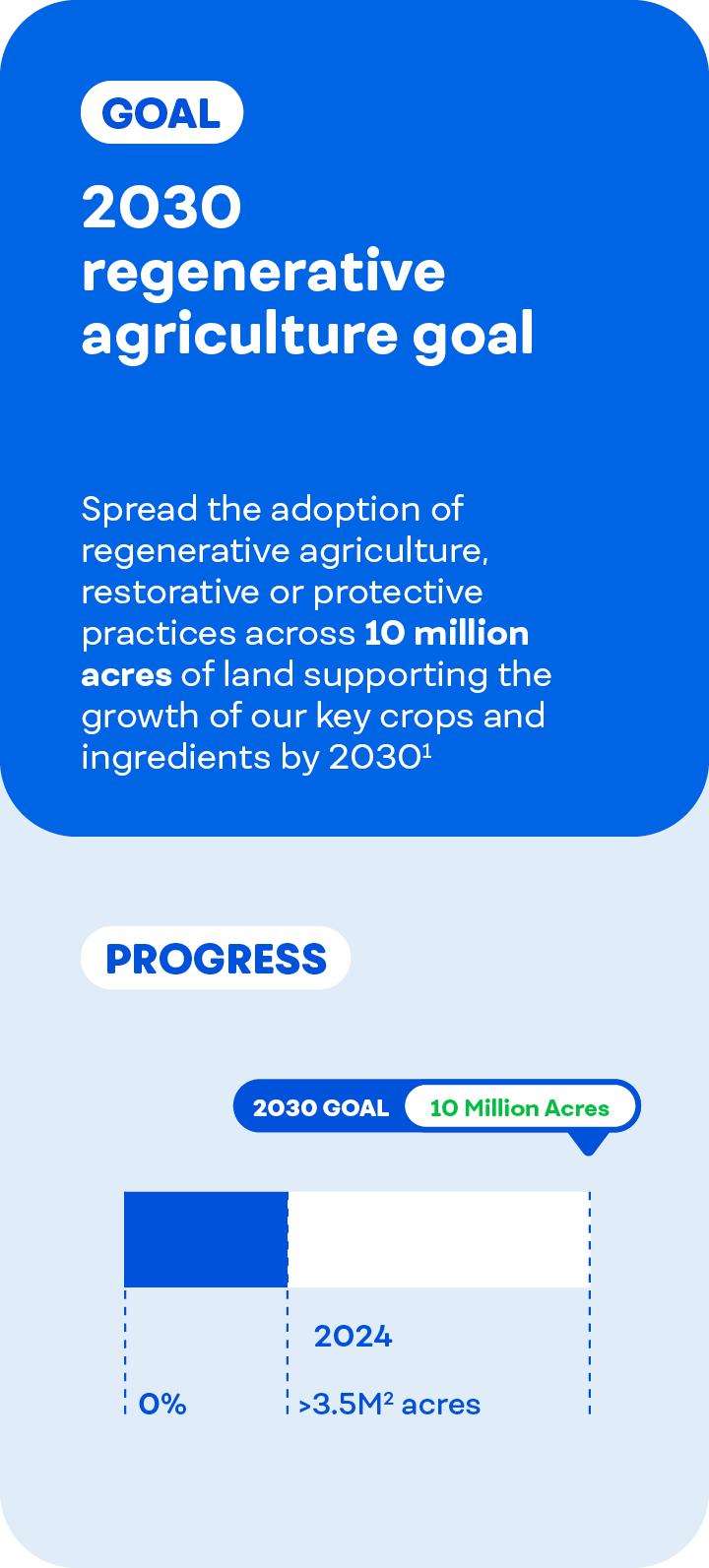
1. See PepsiCo’s Regenerative Agriculture Guidelines for additional information, including details on key crops and regeneration, restoration and protection criteria. Results reflect total acreage meeting these criteria within the annual reporting period.
2. Refined goal announced on May 22, 2025. 2024 performance calculated retroactively. For more information, see Calculation Methodology
Approach to sustainable sourcing
Without a consistent supply of agricultural crops and ingredients, we wouldn’t be able to make our foods and drinks and meet the needs of our customers and consumers. Our sustainable sourcing approach aims to help ensure a steady supply of key ingredients for production while providing a strong risk management foundation.
We continue our efforts to source our key ingredients in line with our Sustainable Sourcing Guidelines. Because systemic barriers beyond our and farmers' control prevent certain ingredients from meeting our rigorous criteria, we have adjusted our goal to sustainably source 90% of our key ingredients and progress volumes (10% or less, reported as “Engaged”) that face systemic barriers towards being sustainably sourced in accordance with our guidelines.1
As of the end of 2024, we sustainably sourced approximately 66%2 of our key ingredients in line with our guidelines, and approximately 1%2 of our key ingredients fell within the Engaged Tier, reflecting volumes that show credible progress in certain areas, despite systemic barriers preventing these volumes from meeting our full Sustainable Sourcing criteria.
We categorize ingredients into one of two pathways:
- Ingredients in the Low-Risk category may qualify as sustainably sourced through a PepsiCo-recognized certification or Verified Volumes pathway (the PepsiCo Sustainable Farming Program, for example) or a qualifying Continuous Improvement program.
- Ingredients in the Not Low-Risk category may qualify as sustainably sourced through a PepsiCo-recognized certification or a Verified Volumes pathway.
For more information on these pathways, and for a full list of key ingredients, please see our Sustainable Sourcing Guidelines.
For more than a decade, we have collaborated with many farmers to adopt practices that build resilience and improve and restore ecosystems through our Sustainable Farming Program (SFP). Like our demonstration farms, this farm-level engagement is also designed to build farmer confidence, address risks and encourage continuous improvement by providing farmers with safe spaces to grow accustomed to new processes and technologies. SFP focuses on self-assessment, capacity building and verification of farm-level sustainable agriculture practices and principles.
A few examples of this program in action are tied to one of our key ingredients: potatoes.
- All potatoes used in United States manufacturing in 2024 were sourced through our SFP. The program also supported the adoption of regenerative agriculture practices, contributing to greenhouse gas emissions reductions and removals.
- All of our grower-sourced potato volume from Thailand is SFP-certified, helping to deliver regenerative agriculture impacts.3 The program has reached thousands of farmers, supporting local livelihoods while delivering environmental benefits through improved soil health and resource efficiency.

~66%
of our key ingredients are sustainably
sourced in accordance with our guidelines2

~1%
of our key ingredients
fell within the Engaged Tier2
1. Sustainably sourced refers to in-scope ingredient volumes that meet the established criteria outlined in PepsiCo’s Sustainable Sourcing Guidelines. Sustainable Sourcing practices can help manage risks, but challenges like deforestation or social issues can persist in some regions
2. Refined goal announced on May 22, 2025. 2024 performance calculated retroactively. For more information, see Calculation Methodology
3. Refer to PepsiCo’s Regenerative Agriculture Practice Bank for an indicative listing of practices directly or indirectly linked to the five impact areas
Sustainable sourcing goal
In May 2025, we refined our sustainable sourcing goal. Our 2024 ESG reporting suite, which includes this Summary and the Agriculture and Palm Oil ESG Topics A-Z pages, represents the first time we are reporting progress against this evolved goal.

1. Sustainably sourced refers to in-scope ingredient volumes that meet the established criteria outlined in PepsiCo’s Sustainable Sourcing Guidelines. Sustainable Sourcing practices can help manage risks, but challenges like deforestation or social issues can persist in some regions
2. Refined goal announced on May 22, 2025. 2024 performance calculated retroactively. For more information, see Calculation Methodology
Approach to deforestation- and conversion-free sourcing
We believe that forests are essential to the world. From conserving biodiversity to storing carbon and preserving the quality of water and air, forests are crucial to natural ecosystems and communities across the globe.
As a business that relies on a secure source of crops and ingredients to make our foods and drinks, our business is linked to forests through our sourcing of paper- and wood-based materials and raw agricultural materials, such as palm oil, soy, cocoa and sugarcane. We have a vested interest in helping to protect the world's forests and natural ecosystems.
Our Stewardship of Forests and Natural Ecosystems Policy outlines our aspirations. In May 2025, we combined our deforestation- and conversion-free goals into one goal to continue to strive toward deforestation-free sourcing by 2025 and toward deforestation- and conversion-free sourcing by 2030 for high-risk commodities in our company-owned and -operated activities.1
We strive to implement our Stewardship of Forests and Natural Ecosystems Policy in our agricultural supply chain where there is high risk of forest and natural ecosystem deforestation and/or conversion. For example, in our palm oil supply chains we expect suppliers to adhere to our No Deforestation, No Peat and No Exploitation (NDPE) commitments as outlined in our Global Policy on Sustainable Palm Oil.
In 2024, PepsiCo took steps toward achieving our 2025 deforestation-free goal in three key areas: enhancing traceability of the ingredients and materials that we source; leveraging technology to assess progress in the field and inform engagement with suppliers; and strengthening partnerships.
- Enhancing traceability: PepsiCo focused on enhancing traceability in our supply chain. We worked to identify the origins for in-scope ingredients and materials procured at the scale needed to confirm the deforestation- and conversion-free status, which may include to the aggregator or to the farm itself. This is a foundational step for progress toward our goal.
- Leveraging technology: we collaborated with Satelligence, a satellite monitoring platform, to help improve our capability to monitor deforestation events, detect and respond to early alerts and verify origins as deforestation-free in our palm oil (global coverage), sugarcane (Mexico) and cocoa (Brazil, Mexico) supply chains.
- Strengthening partnerships: we deepened our partnerships with industry coalitions that support companies to deliver on deforestation and conversion-free sourcing goals, such as the Consumer Goods Forum’s Forest Positive Coalition. We also joined new initiatives: PepsiCo formally joined WWF Forests Forward, focused on corporate action in support of nature, climate and people. At the field level, we continued to invest in landscape initiatives that support conservation, sustainable livelihoods and sustainable production in ingredient supply chain origins where forest and conversion risk exists. For example, we invested in a new initiative with our peers in Aceh, Indonesia aimed at respecting Indigenous Peoples and local community rights.
For more information on our stewardship of forests and natural ecosystems in our supply chain, see Deforestation and our Sustainable Sourcing Guidelines.
1. PepsiCo set this ambition in its Stewardship of Forests and Natural Ecosystems Policy. High-risk commodities include ingredients and materials at high risk of deforestation and conversion as defined in our Calculation Methodology. Systemic challenges continue to be an industry-wide barrier to reaching fully deforestation-free sourcing, but we continue striving toward this ambition and expect to reach more than 90% by the end of 2025
Deforestation- and conversion-free sourcing goal
In May 2025, we combined our deforestation- and conversion-free ambitions across the ingredients in scope of this target into one goal. This Summary shares qualitative progress and actions taken in pursuit of this goal. Industry-aligned methodologies are under development for conversion-free sourcing for most ingredients, and PepsiCo continues to assess scope and timing of reporting on our progress toward conversion-free sourcing. In the interim, we plan to report quantitative progress toward our deforestation-free sourcing ambition as data become available.
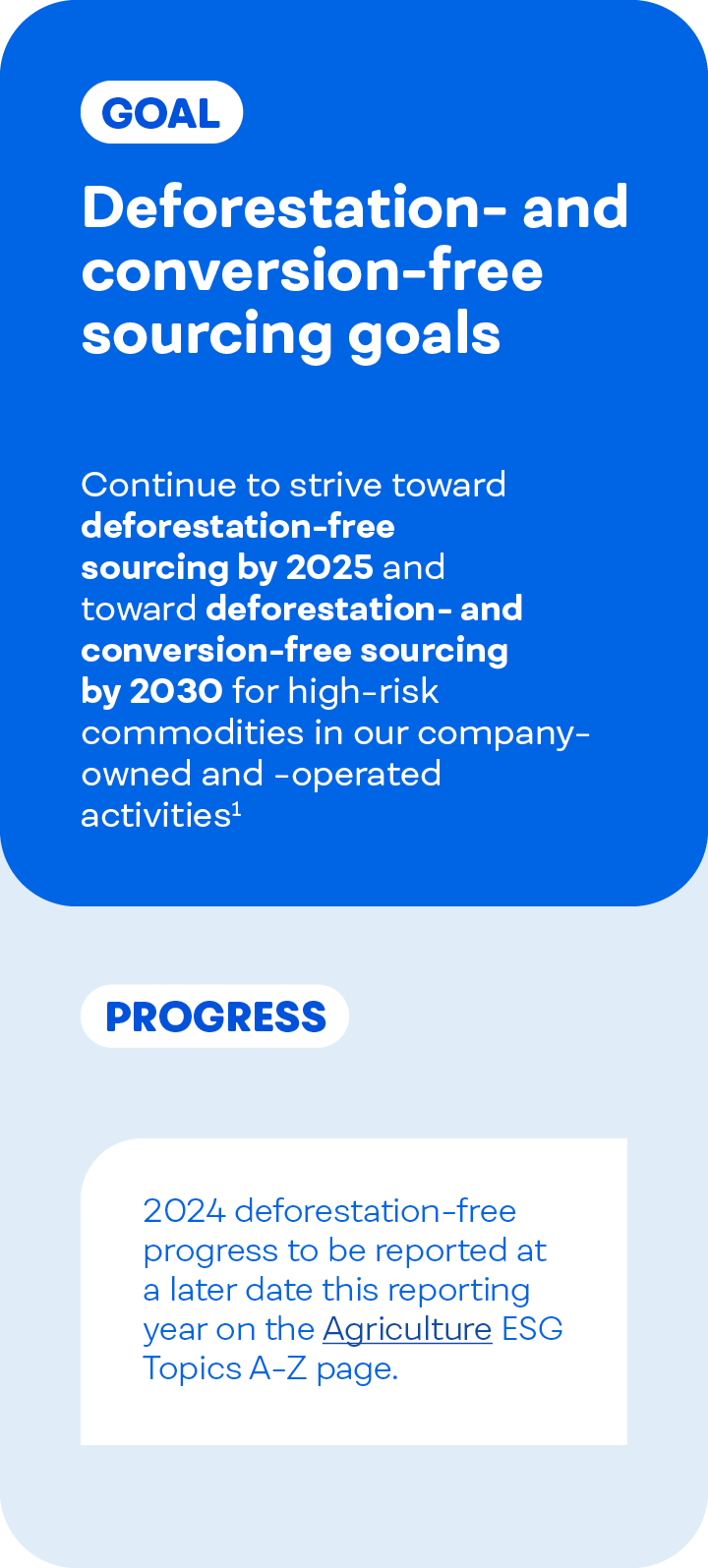
1. PepsiCo set this ambition in its Stewardship of Forests and Natural Ecosystems Policy. High-risk commodities include ingredients and materials at high risk of deforestation and conversion as defined in our Calculation Methodology. Systemic challenges continue to be an industry-wide barrier to reaching fully deforestation-free sourcing, but we continue striving toward this ambition and expect to reach more than 90% by the end of 2025
Approach to supporting sustainable livelihoods
Our business relies on farmers and the crops and ingredients they grow. However, farmers and agricultural communities face many challenges that threaten both their livelihoods and our collective food systems — from extreme weather events to topsoil depletion and other risks.
Among the most vulnerable farming communities are smallholder farmers and farm workers. We recognize that we cannot solve the challenges facing farming and agricultural communities alone, but we hope our efforts will help promote more resilient agriculture practices and improved economic prosperity and farmer and farm worker security.
Helping encourage more sustainable and inclusive food systems not only supports farmers, but is another way we work to secure the supply of ingredients our business depends upon. Supporting resilience for farming communities relies on a farmer-centric approach. In order to achieve this, we rely on strategic partnerships across certain geographies, sectors, industries and supply chains in an effort to drive landscape-level scale and impact.
Our Livelihoods Implementation Framework for Engagement (LIFE) provides a roadmap for our programming with vulnerable communities in targeted sourcing regions and defined metrics to help us credibly measure the impact of our ongoing efforts, with a focus on trying to drive outcomes across three areas: economic prosperity, farm and farm worker security and inclusion and economic empowerment.
LIFE was designed to advance a set of common indicators and metrics that reflect industry best practice and global norms and standards. These indicators are aligned with international norms including the United Nations’ (UN) Sustainable Development Goals (SDGs), International Labor Organization (ILO), UN Food and Agriculture Organization (FAO) and UN Guiding Principles on Business and Human Rights. We expect our framework to evolve in response to learnings from implementation, emerging good practice and partner feedback.
Additional examples of our efforts to support sustainable livelihoods include:
- Agrovita is a collaboration with the PepsiCo Foundation and non-profit Proforest which aims to support inclusion and economic empowerment, including of smallholder farmers in Southeast Mexico to grow crops in a more sustainable way. The program has garnered support from partners such as the Walmart Mexico Foundation, Technoserve and ECOM. The first rural cooperative formed through this collaboration now sells plantains to PepsiCo Mexico Foods for use in producing Natuchips.
- She Feeds the World is a multi-country partnership between the PepsiCo Foundation and CARE which aims to improve food security around the world by economically empowering small-scale producers and expanded to Türkiye in 2024. Since 2018, it has supported farmers in Uganda, Egypt, Peru, Colombia, Vietnam, Thailand and Pakistan and has reached over 3.6 million farmers and members of their communities.

>185,000
livelihoods with measurable
improvements since 20211

>3.6MM
farmers & community members reached with
PepsiCo Foundation and CARE’s partnership
1. This goal captures the number of livelihoods reached through an outcome-focused evaluation measuring improvements in economic prosperity and farmer and farm worker security. Metric counts the cumulative people impacted since 2021
Improving livelihoods goal
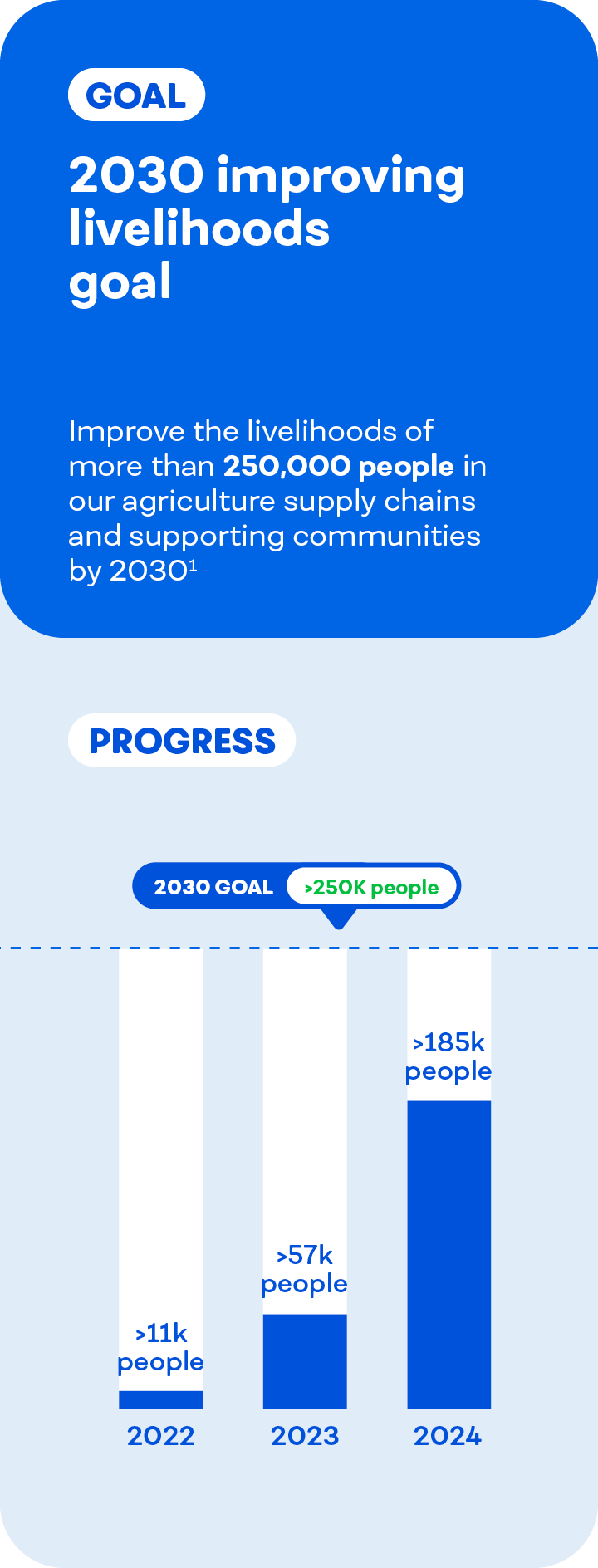
1. This goal captures the number of livelihoods reached through an outcome-focused evaluation measuring improvements in economic prosperity and farmer and farm worker security. Metric counts the cumulative people impacted since 2021
Learn more about PepsiCo’s key agricultural strategic collaborations, how they strive to contribute to progress toward 2030 pep+ goals and the growing resilience and sustainability of our agricultural supply chain.
Explore agriculture topics in more depth
PepsiCo's ESG Topics A-Z provides detail on strategy, data, policy, progress and more on a wide range of subjects.
Positive Agriculture stories
PepsiCo Foods North America launches new "Planting Pathways Initiative" to expand opportunities in the agriculture sector
Learn moreOur 2024 ESG Performance Metrics
This download contains detailed performance data, tracking progress against our goals.
